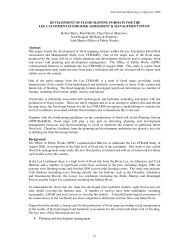Vegetation (Floating River Vegetation) - Office of Public Works
Vegetation (Floating River Vegetation) - Office of Public Works
Vegetation (Floating River Vegetation) - Office of Public Works
Create successful ePaper yourself
Turn your PDF publications into a flip-book with our unique Google optimized e-Paper software.
3.5 Parameters affecting species distribution<br />
As described in the habitat classification <strong>of</strong> Water Courses <strong>of</strong> Plain to Montane Levels with<br />
Aquatic <strong>Vegetation</strong> EU 3260 a characteristic <strong>of</strong> watercourses supporting floating river vegetation is<br />
the periodic rise and fall in water level in winter and summer, respectively. Low water levels in<br />
summer provide aquatic plant species an opportunity to flower and also an opportunity for<br />
terrestrial species to colonise aquatic environments. Low water levels reduce the competitive<br />
advantage aquatic plants possess in aquatic environments.<br />
The following dataset is a correlation between the physical parameters observed on-site at<br />
each sampling point with that <strong>of</strong> floating river vegetation. Survey sites containing floating river<br />
vegetation have been highlighted in blue in the tables in Appendix E.<br />
During the survey <strong>of</strong> the Owenriff <strong>River</strong> square the majority <strong>of</strong> the watercourses surveyed<br />
were found to be in flood. Not alone was the water flowing at a fast rate but it also had a brown peat<br />
colour similar in colour to peat (probably surface run-<strong>of</strong>f from surrounding habitats, see table 2.3).<br />
Those watercourses not in flood did possess floating river vegetation. It is highly probable that the<br />
gravel base <strong>of</strong> the Owenriff <strong>River</strong> would support floating river vegetation but the shade recorded at<br />
some <strong>of</strong> the sites surveyed would not favour aquatic growth.<br />
<strong>Floating</strong> river vegetation was recorded in all but one watercourse in the Clare <strong>River</strong> square.<br />
All watercourses in this survey square are maintained by the <strong>Office</strong> <strong>of</strong> <strong>Public</strong> <strong>Works</strong> and are not<br />
shaded. Depth and river base did vary between survey sites. The survey site in the middle <strong>of</strong> a bog<br />
(section 2.3) was the only site without floating river vegetation. Recent work on the watercourse<br />
and the acidity <strong>of</strong> the surrounding bog habitat may have prevented floating river vegetation growth.<br />
As with the <strong>River</strong> Clare square floating was recorded in all but one watercourse. All<br />
watercourses in this survey square are maintained by the <strong>Office</strong> <strong>of</strong> <strong>Public</strong> <strong>Works</strong> and are not<br />
excessively shaded. A selection <strong>of</strong> riverbed substrates and water depth was recorded. Site 2 was the<br />
only site where water was not evident as the channel was colonised by a selection <strong>of</strong> tall aquatic<br />
vegetation growth. The presence <strong>of</strong> water parsnip would indicate that still and / or shallow water<br />
was present. Colonisation <strong>of</strong> site 3 with scrub vegetation such as willow would not favour aquatic<br />
species and was the only site that did not support floating river vegetation.<br />
Shade appeared to be a significant parameter influencing the growth <strong>of</strong> floating river<br />
vegetation. Although partial shade was noted for site 1 and site 3, considerably less light (morning<br />
eastern sun) was available at site 1. This was reflected in the growth <strong>of</strong> moss only as opposed to<br />
water crowfoot, Ranunculus, and moss recorded at site 3. Site 4 comprised <strong>of</strong> a small cascading<br />
stream that collected in pools. The watercourse was surrounded with tall woodland trees providing<br />
constant shade. No aquatic vegetation was recorded at the site, not even moss as observed in site 1<br />
(section 3.2). Though slight turbidity was noted due to the cascading water it unlikely that this<br />
26

















